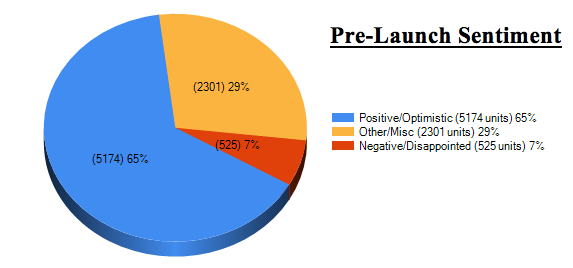For Apple, last week will be remembered as one of its toughest and finest on record, and not just for its tumultuous stock prices, but for the staggering range of emotions that the company evoked throughout the week.
The week began with news that frustrated the apple community: After months of tech-speculation, an iPhone 5 would not be hitting the streets as expected. What many concluded was either a disinformation campaign or just bad P.R., the iPhone 4S launch was supposedly a disappointment for many, but how can we be so sure? Bloggers and journalists were clearly saddened, but for all we know, their unhappiness stems from the thousands of hits their blogs won’t receive and the millions of copies their papers won’t sell… If journalists and bloggers want to gauge sentiment, they should probably start with Social Media analysis like we do.
Using the new GNIP Power Track in DiscoverText, we tracked and recorded every use of the word “iPhone” on twitter from about 3:00am on October 3rd to about 10:30pm on October  6th. All told, we collected about 3.1 million tweets. Prior to mid-morning on the 4th, we were ingesting about 4 iPhone tweets per second, but by late afternoon we were collecting about 130 tweets per second. By the morning of the 6th, social media chatter had settled-down a bit and leveled out to about 7 tweets per second. Our question was: what sentiment laid beneath this noise of jokes, links, advertisements, announcements, and irrelevance?….Only one way to find out: DiscoverText Classification.
6th. All told, we collected about 3.1 million tweets. Prior to mid-morning on the 4th, we were ingesting about 4 iPhone tweets per second, but by late afternoon we were collecting about 130 tweets per second. By the morning of the 6th, social media chatter had settled-down a bit and leveled out to about 7 tweets per second. Our question was: what sentiment laid beneath this noise of jokes, links, advertisements, announcements, and irrelevance?….Only one way to find out: DiscoverText Classification.
 We split our data into two subsets, the first contained only tweets prior to the launch that mentioned “iPhone,” whereas the second contained tweets a few hours after the launch. (This is because for a few hours after the launch, some people still didn’t know that iPhone 5 was not coming.) By quickly programming a sentiment classifier, we concluded that prior to the Phone 4S launch, 65% of the iPhone comments were positive, optimistic, or enthusiastic, and just a few hours later only 26% of the iPhone comments were positive and 40% of them were negative.
We split our data into two subsets, the first contained only tweets prior to the launch that mentioned “iPhone,” whereas the second contained tweets a few hours after the launch. (This is because for a few hours after the launch, some people still didn’t know that iPhone 5 was not coming.) By quickly programming a sentiment classifier, we concluded that prior to the Phone 4S launch, 65% of the iPhone comments were positive, optimistic, or enthusiastic, and just a few hours later only 26% of the iPhone comments were positive and 40% of them were negative.
Bloggers and Journalists were – indeed – correct, and these numbers demonstrate that. Check back soon for a sentiment analysis on the passing of Steve Jobs.


